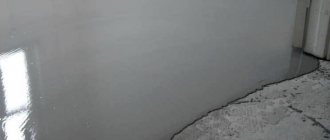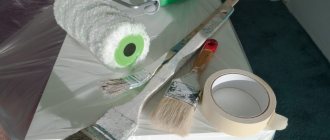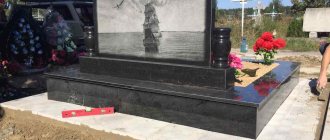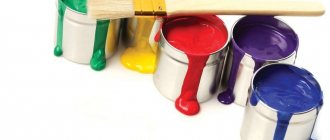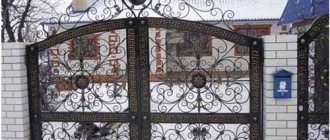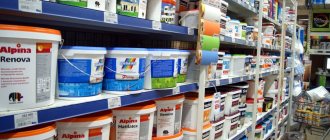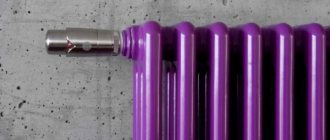Requirements for a concrete floor
A garage is an unusual room in terms of the loads acting on its floor. This means that there are specific requirements for the applied finish. Especially when it comes to paint.
Here are some of the main factors that affect garage flooring:
- heavy weight of the car , that is, the requirement for the floor is high strength;
- when driving into a garage box, the car slows down, and these are increased horizontal loads that affect the abrasion of the surface, that is, the latter indicator should be low;
- when it rains or snows outside, the car wheels become wet, which means the floor must have high waterproofing characteristics ;
- road chemicals, gasoline, technical oils and anti-corrosion compounds negatively affect concrete, that is, when painting a concrete floor in a garage, one must take into account the chemical resistance of the paint used;
- if the garage is an unheated building, then temperature changes .
A car creates serious loads on the floor in the garage Source me.ayokonseling.com
What happens is that the paint for the garage floor should be as durable as possible in terms of the applied layer, with a low coefficient of abrasion, inert to chemicals, and withstand changes in humidity and temperature.
Don't forget about the color scheme of the floor. For example, a light-colored floor is a visual expansion of the space, its uniform lighting; on such a floor it is easy to find small fallen objects. But the light surface quickly becomes dirty, that is, even small stains from water from the wheels are clearly visible on it.
Features of concrete staining
Painting a concrete floor in a garage has a number of its own characteristics. Having chosen even the highest quality paint and varnish material, you should not count on the durability of the coating if initially cement of a grade lower than M400 was used for the concrete screed. In addition, all manufacturers of paint and varnish products write that the paint is applied to a prepared concrete base. By “prepared” we mean the presence of a primer layer. It is needed for better adhesion of the surface to subsequent coating. There are two optimal compositions for painting a concrete floor in a garage:
- The primer forms a glossy film on the surface. The surface becomes resistant to moisture, chemicals and mechanical damage.
- Polyurethane compounds simultaneously make the surface smooth, durable and fill all the pores in the screed. The primer dries quickly, which reduces the time it takes to arrange the garage. Provides good adhesion and is impervious to chemicals.
Due to the porous structure of concrete, a lot of dust accumulates on the surface, so before painting it is advisable to wash the surface and wait for it to dry. It is also necessary to check the humidity level in the room.
Advice! You can check the humidity by sticking a piece of plastic bag on the wall. If after 24 hours condensation has formed underneath, then the floors are painted with epoxy compounds.
Enamels are applied to the concrete screed no earlier than 3 months after pouring. This time is enough for the cement mortar to dry completely. The technology for applying coloring compounds depends on the recommendations of the paint manufacturer. They can be applied in one or two layers. Each subsequent layer is applied only after the previous one has completely dried. It is also important to maintain the temperature in the room. Rubber paint is the most resistant to temperature fluctuations. It can be applied at temperatures ranging from -50 to +50 degrees. Acrylic compounds are applied from +18 degrees and above, epoxy – from +5.
Before painting, the floor must be primed
The process of painting a concrete floor Please note: Types of paint for glass painting
Choosing paint
So, we’ve sorted out the requirements for a garage floor. Let's move on to the choice. Today, manufacturers offer a fairly wide range of paint and varnish products, which are used for finishing the concrete floor base in the garage. The model range consists of paints on different bases. We will deal with them.
The first on the list is the popular acrylic paints, also known as latex paints. The positive characteristics of this material include good moisture resistance, abrasion resistance, and inertness to chemicals. The paint is one hundred percent safe and harmless. It has excellent color rendition throughout its entire lifespan. As for the disadvantages, there is only one – the high price. For example, the price of Betoxyl paint is 180-190 rubles/kg.
Acrylic paint for concrete floors Source pol-spec.ru
Second on the list is epoxy paint. Positive characteristics include high strength of the treated surface, low abrasion, easily tolerates changes in humidity, even large volumes of water, good chemical inertness, can be applied to floors even at sub-zero temperatures. The disadvantage is that it is a two-component material, the ingredients of which must be mixed before using the paint, which takes time.
Alkyd-urethane is in third position. We need to start with a minus - this is the average strength of the applied material, hence the high abrasion. But it should be noted that with proper application, taking into account good hiding power, and proper use of the floor, this type of paint will last a long time. Such paints are usually produced with glossy films after drying.
Polyurethane paints for concrete on garage floors are the most wear-resistant and have a heavy-duty film. They easily tolerate low and high temperatures, as well as changes in humidity. One hundred percent inert to chemistry. Like the epoxy variety, this is a two-part type. But today manufacturers also offer one-component compositions; the photo below shows just such material.
One-component polyurethane paint for concrete floors Source ms.decoratex.biz
See also: Catalog of companies that specialize in paints and varnishes.
So, we've sorted out the paints. But I would like to focus on one term - rubber paint. Many people ask why it is called that, and whether the material contains rubber or its components. We can definitely say that there is nothing in the composition except latex, pigments and water. Various substances that improve performance can be added, but they have nothing to do with rubber. But it should be noted that latex is a component in the production of synthetic rubber and various adhesive compositions.
The name came about only because the paint applied to the concrete floor is similar in structure to a rubber coating. That is, it is very elastic.
Rubber paint for concrete floors Source remoo.ru
That is, we can say that rubber paint belongs to the category of acrylic paints, which were mentioned in the list. This variety just has higher technical characteristics. For example, material applied to the floor can expand 3-4 times. This means that the finish will not crack if the concrete floor itself is cracked, it can easily withstand sudden temperature changes, has excellent waterproofing qualities, and dries quickly. At the same time, a floor painted with rubber paint will last up to 12 years if the painting process is carried out correctly. And it is based on one small nuance - the paint is applied in thin layers in an amount of at least three.
Types of primers
Concrete floor primer can be different - depending on what substances are used as a base, the properties, operating conditions, application rules, consumption, drying time and other nuances may vary. Before choosing one or another composition, it is necessary to carefully study its features.
Alkyd
Such primers are used to coat metal and wooden surfaces; the composition is not suitable for drywall and concrete. Apply primer before painting the surface, wait 10-15 hours for complete drying. Applying a layer of such a primer gives the wood a certain looseness, thanks to which the material is reliably protected from mold, parasites, and rot, and the subsequent layer (of concrete mortar, for example) adheres tightly to the wood.
Acrylic
Acrylic compounds are used very often as the safest and most versatile. The water-based mixture is easily diluted (usually with water) and has excellent penetrating properties. It dries quickly (after 3-4 hours you can already work on the surface), does not emit harmful substances or toxins, significantly improves adhesion, and protects against fungus and mold.
This soil is suitable for treating any residential premises (even children's rooms, kitchens), with the exception of those where there is a high level of humidity.
Epoxy
Epoxy primer for concrete floors makes the surface much more durable, has no odor and does not emit any harmful substances, and provides high-quality protection from any aggressive environments, water, high levels of humidity, and fuels and lubricants. The composition significantly improves the adhesion of materials; it is applied to a slightly moistened floor. The only drawback of the mixture is that the layer must be applied quickly, since within 30 minutes the prepared mixture will already set.
Polystyrene
It is best to prime plastered and wooden surfaces with this type of composition, since the primer is toxic and should not be used in confined spaces (at a minimum, there should be the possibility of high-quality ventilation of the room). It is imperative to follow safety rules while working. Typically, such compositions are used for subsequent installation of self-leveling floors.
Other types of soils
Different types of bases are primed with other compounds. Some of them are suitable for a certain material, others are relevant for use in certain situations and conditions.
Different types of primers:
- Mineral
– may include cement, film-forming substances, glue, antiseptics, adsorbent and water-repellent components. This primer is suitable for concrete bases, dries quickly, is absolutely safe, but does not withstand interaction with aggressive substances.
- Liquid glass
– used to make concrete resistant to moisture and water. The composition is usually based on sand, soda, and silicates. This primer is applied to a concrete floor and creates an ideal waterproof surface. It sets quickly, but does not last long.
- Glypthal primers
– usually used for processing metal, making the base more durable. Relevant exclusively for interior work, dry within 24 hours.
- Perchlorovinyl compounds
– suitable for brick and plastered surfaces (exterior work). Concrete areas located outdoors can be treated. The primer dries quickly - within one hour.
- Polyvinyl acetate
– are used when it is planned to cover the base with polyvinyl acetate paint. Suitable for all types of floors, drying in 15 minutes, allowing you to reduce the amount of paint and varnish materials consumed in subsequent processing.
How to properly paint a concrete garage floor
Like many construction processes, painting a concrete floor consists of two main stages: preparatory and painting.
Stage No. 1 – preparation
It should be noted that the concrete floor, or rather, its top layer, under the influence of loads, begins to crumble into small particles, turning into dust. The latter is an obstacle to bonding the paint and varnish material to the concrete surface. Therefore, do not forget that before applying paint, the floor must be dust-free. But before that, you need to examine the concrete surface to detect flaws and defects.
Concrete floor defects Source it.decorexpro.com
Useful tips
Despite the apparent simplicity of painting a concrete floor, there are some nuances in this process that affect the quality of the final result. Here's what experts advise:
- It is very important to paint a dry concrete floor . Excess moisture reduces the adhesive properties of the concrete structure. That is, the paint will simply begin to peel off after some time of use.
- Sometimes you shouldn't use a vacuum cleaner. It is better to wash the floor and let it dry thoroughly.
- Painting should be carried out with good ventilation inside the garage. If the construction is of a small area, then the process is carried out with the gates open.
- From experience, many craftsmen know that the ideal tool for painting floors, especially concrete, is a paint roller . With its help, optimal coverage is achieved.
Applying paint with a roller Source console-scene.info
Paint prices
In fact, the price difference between paints is quite large. For example, rubber concrete paint for a garage floor costs 200 rubles per 1 kg. Epoxy - 400-450 rub./kg, polyurethane from 480 to 500 rub. for 1 kg. And the most expensive is alkyd-urethane - from 500 to 600 rubles / kg.
That is, when choosing paint for a concrete floor, you should not miss this indicator. Of course, the cheaper the material, the less it lasts. But innovative production technologies prove the opposite. For example, comparing rubber and polyurethane paint coatings. If the service life of the first does not exceed 12 years, then the second is 15. And then it is worth purchasing a second one, which is twice as expensive.
Chemical and technological characteristics
This product is an acrylic emulsion, which is made on a water-dispersion basis using acrylate synthetic latex - a material that has increased elasticity, is resistant to aggressive temperature conditions and is extremely low. Hygroscopicity.
In addition to water, the chemical composition of paint also contains:
- A coalescent is a special functional additive that provides increased adhesion of the applied layer to the surface of the treatment, and in addition, with natural evaporation (up to 96% in 3 hours at a temperature of +26 degrees) creates a protective outer film.
- An antifungal additive is a chemical compound that can destroy and prevent the growth of mold and pathogenic fungi for a long time.
- Antifreeze additive is a component that regulates the rate of hardening of the layer and actively resists aggressive temperatures.
- Coloring additive is a paste of different shades that contains an inorganic pigment with increased light resistance.
Operational and technical characteristics
Rubber paint for concrete floors has the following characteristics:
- Able to withstand temperature changes from -55 degrees to +50 degrees (some types can withstand from -82 to +80 degrees).
- Insensitive to environmental influences.
- It has increased adhesion properties, which helps ensure high quality adhesion of layers to the processing surface.
- Once the paint is completely dry, it is non-slip.
- It has no reserve and is non-toxic; you can perform work without using a respirator.
- Has fire resistance.
- Matte (if you plan to use it for roofing work, semi-matte).
- It tolerates cleaning well, even if you use a brush, water, alkaline, antiseptic and other detergents.
When everything is completely dry, the surface treated with paint feels like soft rubber, rubber, and its elasticity is at least 360%.
The advantages of rubber paint for concrete garage floors is that the weight to volume ratio is 1.1 kg = 1 liter of paint. One layer, which has an average thickness of 50 microns, will harden completely in 12 hours, and will stop sticking after a couple of hours at a room temperature of 25 degrees. Dry residue can be up to 50%. The warranty period for use of the coating is 10 years (if the paint is wear-resistant, then 20 years). The shelf life of the product in a closed container is up to 3 years, and after opening for another six months. The storage conditions for rubber paint for concrete floors are as follows: from -5 degrees to +25. When freezing and cooling (no more than 5 cycles in 1 month at a temperature of -20 degrees), the paint can be defrosted, and for this you need to leave it at room temperature for at least a day. Before use, be sure to stir it until the bottom sediment disappears.

